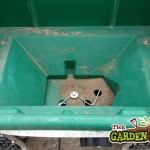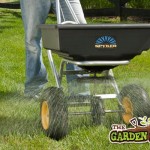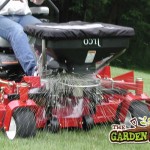Fertilizer spreader can be put to many uses in the garden. They offer a quick and safe way to spread a range of granular products mostly lawn seed and fertilisers. But they can also be used to spread lime, pest control products, moss killer and wild flower seeds. Each of these have different application rates. They also all way differently and come in different sizes. It is for these reasons that a fertilizer spreader needs to be calibrated each time and for each different application.
- Inside Fertiliser spreader
- Fertiliser spreader
- Spreader
Before you can calibrate your spreader you need to first know the application rate of the product that you are spreading. So here are some examples of the most common spreads & seeds:
- Lawn Seed: 35g /m2
- Wild Flower Seeds: 4g /m2
- Garden Lime: Depends on soil acidity. Can apply 500g / m2
- General lawn feed: 35g / m2
- Lawn weed feed & Moss killer: 30g /m2
- Ammonium Sulphate: Depends on use. 35g / m2 as a fertiliser. 70g /m2 as a pH lowerer
- Potassium Sulphate: 30g /m2
- Super Phosphate: 100g / m2
- Fish Blood & bone: 70g /m2
The above is an outline of application rates and it can vary from one manufacturer to the next so you would be advise to read the labels. Applications rates also vary depending on use.
The second point to note is the area you wish to cover. Lawns, vegetable plot and borders should be measured to determine their total size. Once you know this you can determine the quanitity of product you need. For example; a lawn that is 20m x 80m = 1600m2, so if you wanted to apply lawn weed feed and moss killer you would be 48000 grams or 48 kg
When using a fertilizer spreader you can really achieve a nice even application. To ensure an even spread of the product over the entire area you should divide both the area and the product in equal parts. Using the example above you could divide the garden in 8 equal parts of 20 x 20m and also divide the 48kg of lawn weed feed and moss killer in 8 equal parts of 6kg.
With these smaller areas and volumes you can quickly determine the necessary flow rate for an even and accurate application. You can divide your lawn using a garden string line and divide the product using buckets and a scales, or 8 similar buckets. Once done, fill the fertilizer spreader with the 6Kg and set your spreader to its lower setting of approx. 25% open (i.e. on a scale of 1 – 20, set the spreader to 5). It is best to start at a lower setting and work your way up to the most suitable setting through trial & error
Start at the beginning of the 20 x 20m section and begin spreading. Keep a close eye on the drop rate and flow rate from the hopper. If you notice that you are 1/4 of the way through the first section and less than a 1/4 of the way through the hopper’s contents then you should increase the settings on the fertilizer spreader to increase the flow rate.
By the time you have reached the end of the first section you should have set the spreader to the correct setting. Use this setting for the rest of the lawn / garden area. At the end you can go back over the first patch where your application was too low.


